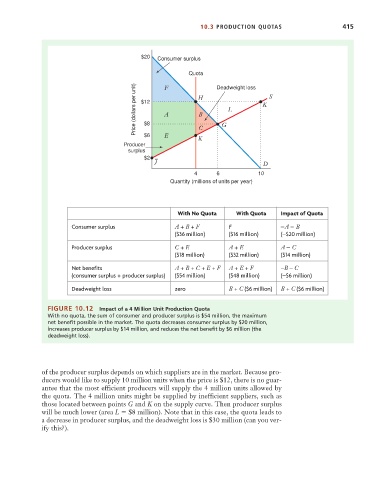Page 441 - Microeconomics, Fourth Edition
P. 441
c10competitive markets applications.qxd 7/15/10 4:58 PM Page 415
10.3 PRODUCTION QUOTAS 415
$20
Consumer surplus
Quota Deadweight loss
Price (dollars per unit) $12 A H L K S
F
B
$8
$6
E C G
K
Producer
surplus
$2
J
D
4 6 10
Quantity (millions of units per year)
With No Quota With Quota Impact of Quota
C onsumer surplus A + B + F F –A – B
($36 million) ($16 million) ( –$20 million)
Producer surplus C + E A + E A – C
($18 million) ($32 million) ($14 million)
Net benefits A + B + C + E + F A + E + F –B – C
(c onsumer surplus + producer surplus) ($54 million) ($48 million) ( –$6 million)
Deadweight loss zero B + C ($6 million) B + C ($6 million)
FIGURE 10.12 Impact of a 4 Million Unit Production Quota
With no quota, the sum of consumer and producer surplus is $54 million, the maximum
net benefit possible in the market. The quota decreases consumer surplus by $20 million,
increases producer surplus by $14 million, and reduces the net benefit by $6 million (the
deadweight loss).
of the producer surplus depends on which suppliers are in the market. Because pro-
ducers would like to supply 10 million units when the price is $12, there is no guar-
antee that the most efficient producers will supply the 4 million units allowed by
the quota. The 4 million units might be supplied by inefficient suppliers, such as
those located between points G and K on the supply curve. Then producer surplus
will be much lower (area L $8 million). Note that in this case, the quota leads to
a decrease in producer surplus, and the deadweight loss is $30 million (can you ver-
ify this?).

